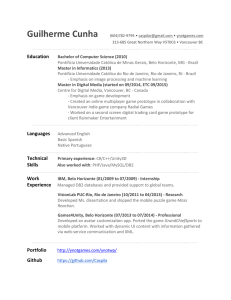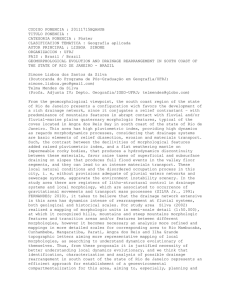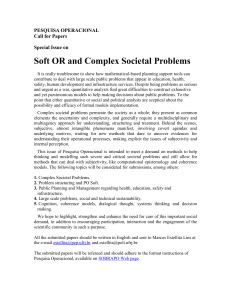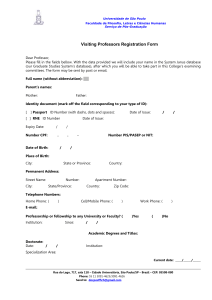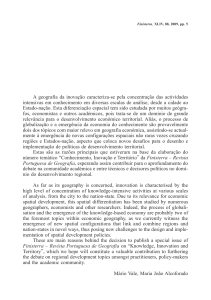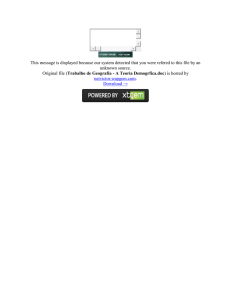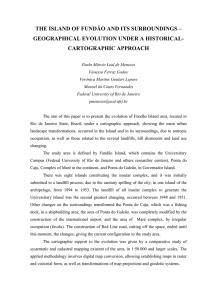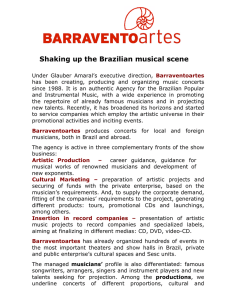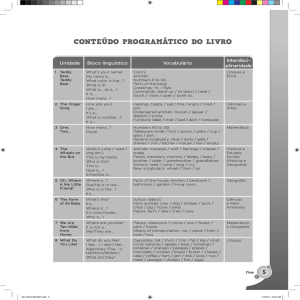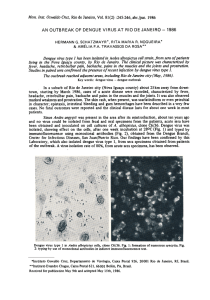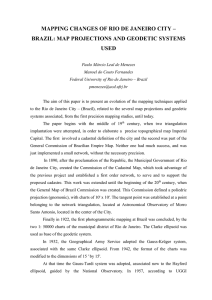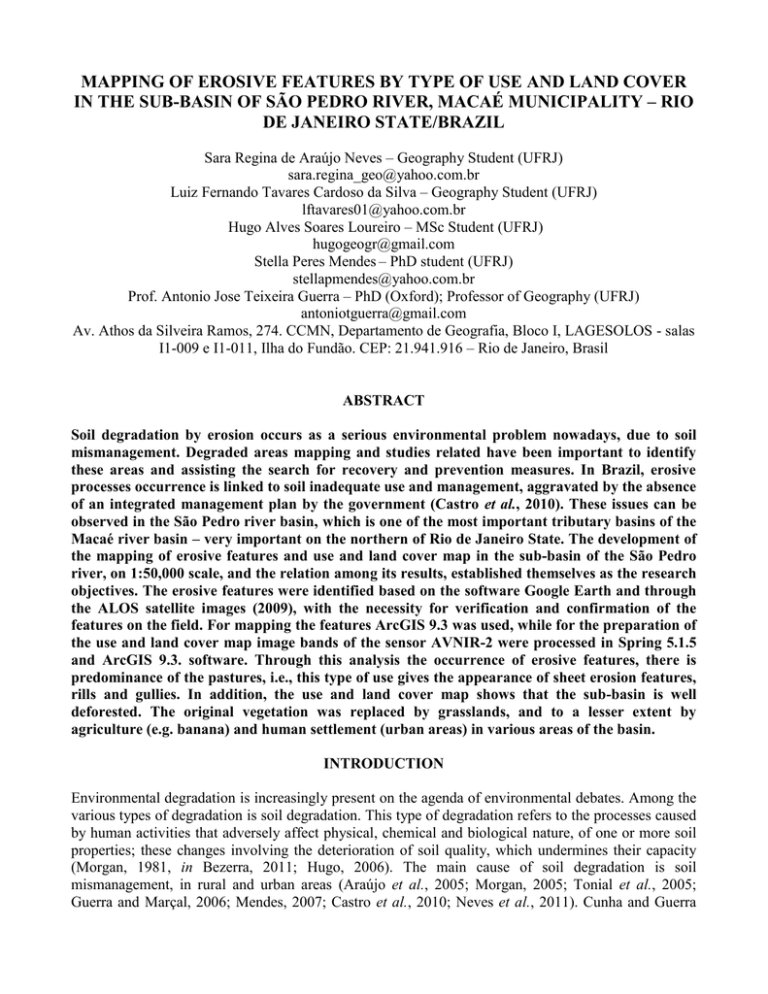
MAPPING OF EROSIVE FEATURES BY TYPE OF USE AND LAND COVER
IN THE SUB-BASIN OF SÃO PEDRO RIVER, MACAÉ MUNICIPALITY – RIO
DE JANEIRO STATE/BRAZIL
Sara Regina de Araújo Neves – Geography Student (UFRJ)
[email protected]
Luiz Fernando Tavares Cardoso da Silva – Geography Student (UFRJ)
[email protected]
Hugo Alves Soares Loureiro – MSc Student (UFRJ)
[email protected]
Stella Peres Mendes – PhD student (UFRJ)
[email protected]
Prof. Antonio Jose Teixeira Guerra – PhD (Oxford); Professor of Geography (UFRJ)
[email protected]
Av. Athos da Silveira Ramos, 274. CCMN, Departamento de Geografia, Bloco I, LAGESOLOS - salas
I1-009 e I1-011, Ilha do Fundão. CEP: 21.941.916 – Rio de Janeiro, Brasil
ABSTRACT
Soil degradation by erosion occurs as a serious environmental problem nowadays, due to soil
mismanagement. Degraded areas mapping and studies related have been important to identify
these areas and assisting the search for recovery and prevention measures. In Brazil, erosive
processes occurrence is linked to soil inadequate use and management, aggravated by the absence
of an integrated management plan by the government (Castro et al., 2010). These issues can be
observed in the São Pedro river basin, which is one of the most important tributary basins of the
Macaé river basin – very important on the northern of Rio de Janeiro State. The development of
the mapping of erosive features and use and land cover map in the sub-basin of the São Pedro
river, on 1:50,000 scale, and the relation among its results, established themselves as the research
objectives. The erosive features were identified based on the software Google Earth and through
the ALOS satellite images (2009), with the necessity for verification and confirmation of the
features on the field. For mapping the features ArcGIS 9.3 was used, while for the preparation of
the use and land cover map image bands of the sensor AVNIR-2 were processed in Spring 5.1.5
and ArcGIS 9.3. software. Through this analysis the occurrence of erosive features, there is
predominance of the pastures, i.e., this type of use gives the appearance of sheet erosion features,
rills and gullies. In addition, the use and land cover map shows that the sub-basin is well
deforested. The original vegetation was replaced by grasslands, and to a lesser extent by
agriculture (e.g. banana) and human settlement (urban areas) in various areas of the basin.
INTRODUCTION
Environmental degradation is increasingly present on the agenda of environmental debates. Among the
various types of degradation is soil degradation. This type of degradation refers to the processes caused
by human activities that adversely affect physical, chemical and biological nature, of one or more soil
properties; these changes involving the deterioration of soil quality, which undermines their capacity
(Morgan, 1981, in Bezerra, 2011; Hugo, 2006). The main cause of soil degradation is soil
mismanagement, in rural and urban areas (Araújo et al., 2005; Morgan, 2005; Tonial et al., 2005;
Guerra and Marçal, 2006; Mendes, 2007; Castro et al., 2010; Neves et al., 2011). Cunha and Guerra
(2006) also claim that the very natural conditions coupled with inadequate soil management can
accelerate its degradation. One type of soil degradation more severe and noticeable is water erosion.
The adoption of the watershed as a planning and management unit of natural resources is important to
evaluate the various elements of the landscape (climate, geology, topography, soil, population) in an
integrated way, understanding the different processes. In terms of watersheds, their natural
characteristics can contribute to slope erosion, and associated human activities cooperate in the
environmental imbalance (Goulart, 1999). Thus, due to its importance in geomorphological studies and
the insertion of the study area in a watershed, it was decided to adopt the term "sub-basin" as the scale
of analysis for this work and for the mapping erosive features and their occurrence in accordance with
use and land cover.
It is in the highlands of the Rio de Janeiro State Macaé River in the town of Nova Friburgo, forming an
outward drainage, in direction into the Atlantic Ocean. It is possible to verify on the drained lands by
basin this river numerous signs of environmental degradation, resulting from centuries of human
activities undertaken in the region, such as cattle raising and sugar-cane cultivation in the seventeenth
century (Lima, 2008).
São Pedro River sub-basin integrates Macaé River basin in its lower course. It is one of the main
tributaries of the Macaé River basin. It has an area of approximately 420 km², and its divisors are limits
with the municipality of Trajano de Morais, between the municipalities of Macaé and Conceição de
Macabu. São Pedro River runs about 50 km, mostly inserted in Macaé municipality, intersecting
Conceição de Macabu municipality in the lower course.
The area is related to the environmental context of the Brazilian southeast region, marked by the
evolution of the Serra do Mar. Its geomorphology is composed of scarped ranges, hilly domain and
river plain areas. The scarped ranges are composed of crystalline rocks, with reworked morphology
marked by structural control, with high slopes, with altitudes above 800 meters, the occurrence of talus
deposits and rock outcrops, and they are areas susceptible to erosion and mass movements. This region
is locally known as Serra de Macaé or Serra Macaense (CIDE, 1989; Cotrim, 2004). The hilly domain
is characterized by agricultural and pasture use, with large areas of pasture, and development of small
urban centers (Cotrim, 2004). In the areas of fluvial plain characterized by the presence of agriculture
and pasture. Figure 2 illustrates, in general, the landscape found in the sub-basin São Pedro River.
Figure 1. Location map of sub-basin São Pedro River.
Figure 2. This picture illustrates, in general, the sub-basin landscape of the São Pedro river regarding
the use and land cover: degraded pasture (terraces) and forest fragments.
Rainfall is well marked throughout the year, causing a higher rain concentration in the summer months,
exceeding 400mm (Nascimento et al., 2010). According to the mapping carried out by CPRM (2001, in
English, RCMR - Research Company for Mineral Resources), 1:500,000 scale, the predominant soils in
the watershed of the São Pedro River are Cambisoils, Litholic Soils, Oxisols, Aluvial Soils, Gleisoils
and Organic Soils. The vegetation is characterized by grasses, which make up the landscape use for
pasture, and forest, Ombrophilous dense type is fragmented and varied physiognomy.
Problems such as rectification and damming of the channel, inadequate land management and removal
of native vegetation, increase of natural grassland, and increased immigration process in the region
over the years contributed to the framework of current degradation (Lima, 2007), especially soil
erosion. The frequency and magnitude of erosive features become worrying, throughout the basin,
since the degradation in some slopes becomes irreversible.
Therefore, the elaboration of erosive features map and use and land cover map in the sub-basin São
Pedro River, on a scale of 1:50,000, and the relationship between their respective results constitute the
work objectives; its purpose is to catalog the different forms of erosion by identifying the types of use
and incidence of sheet, rill and gully erosion features.
THEORETICAL AND METHODOLOGICAL REFERENCE
Soil erosion is a significant environmental problem in Brazil. Soil loss by removing sediment brings
innumerable damages to human settlement, agricultural, landscape and ecosystems, mainly on the
slopes. Therefore several authors ha studied erosion and his impacts in recent decades (Guerra and
Mendonça, 2007; Netto and Sobreira, 2006; Lima, 2008; Bezerra, 2011) highlighting the importance of
integrating structured on the management plan that addresses the socio-economic conditions and
particularities of the environment. According Cunha and Guerra (2006), erosion is a phenomenon that
occurs both from natural causes and human interventions in the environment. Oliveira (1999) describes
that rills and gullies can be considered as incisions that result from the tendency of natural systems to
achieve a state of balance between available energy and efficiency of the system to dissipate energy.
Some soil uses are more likely to erosion as they take place on the areas for agriculture and pasture
that are often marked by the presence of rills and gullies, originated when the capacity of water
infiltration into the soil is exceeded, making the soil to suffer the action of sheet flow. These in turn can
be deepen and broaden, raise bigger features that are gullies, classified as features with width and depth
bigger than 0.5 m (Morgan, 1986).
Selby (1993) and Guerra (2007) point out that the gullies often develop permanent erosive features in
the landscape and it becomes difficult to control and their recovery when they reach that stage. Also
according to Guerra (1999), permanent rills almost always develop into gullies, in other words, diffuse
runoff until the formation of gullies there is a process chained, connecting multiple network channels in
some landscapes.
To help the identification of the areas under erosion process, remote sensing techniques have been used
on the mapping and geographical studies. The use of images in flight level and orbital level has enabled
the spatial analyze more integrated and at regular periodic intervals reliable. Remote sensing can be
defined as a technique to obtain data for a particular object, areas or phenomenon; without that it occurs
direct contact between the target and the sensor (Moraes Novo, 1992 in Barros, 2006; Luchiari et al.,
2009).
In this study, images were used to survey a use and land cover, and to recognize erosion features. For
this purpose, the remote sensing products can be manipulated through digital image processing, that
consist on using softwares, where various operations are made to improve the visual interpretation of
the images. However, computational techniques are not fault-free and field surveys are essential, so
surveys phenomenon and objects possible to represent. In geomorphology, for example, some
processes are not recognized on remote sensing images.
Together, remote sensing and Geographic Information Systems (GIS) have contributed to the
comprehension of earth surface dynamics. Argento (2007) argues that without the GIS it becomes
practically impossible the environmental projects development, so this presence on the geomorphologic
mapping is indispensable. Thus, the identification of areas of erosive processes, usually due to incorrect
use in some geomorphologic forms – as it occurs with agriculture and livestock – are important for
environmental management and prevention of the degradation process.
In this study, the mapping of use and land cover and erosion features identification the images from
Japan satellite ALOS were carried out. There are three different sensors, but for this study only two
were used: AVNIR-2 and PRISM. The first has four spectral bands, equivalent to blue, green, red and
near infrared, has 10 m spatial resolution and 8 bits radiometric resolution, while the second has 2.5 m
spatial resolution, one panchromatic band and 8 bits radiometric resolution.
For mapping of use and land cover were used the software Spring 5.1.5, based on the three visible
bands (red, green and blue) of the AVNIR-2 sensor. It is important to note that further tests will be
made with the infrared band. It has been chosen the semi-automatic classification, where were made
the segmentation, with similarity values of 10 and 10 area also, training and classification.
Classification was made by Bhattacharya method, whose measures the average distance between the
probability distributions for spectral classes (SPRING TUTORIAL, 2009). After this, were made final
adjustments on the map through ArcGIS 9.3 software. The mapped classes were adapted according the
work objective, distributed between, forest, agricultural and pasture areas, exposed soil, anthropic
urban areas, rocky outcrops and other (including water and shadow).
The recognition of the erosion features was made from a visual analyzes of the fusion images of the
PRISM and AVNIR-2 sensors. The fusion image has allowed improving the visual aspect, allowing to
recognize more relief details than analyzing the images separately. As a support field work was carried
out and viewing in Google Earth, in order to eliminate the doubts. Once identified the points of erosion
in the landscape, the correlations were made between the frequency of eroded areas and classes of use
and land cover map.
RESULTS
By analyzing the location of different points of erosive features on the use of map and ground cover, it
was found that there is a direct relationship between the type of use/cover and the occurrence of erosive
features. This fact was observed both in the ALOS satellite image (2009), in field work, and Google
Earth, where these features are located preferentially along the area of human settlement, where it
gives the highest incidence areas cleared for grazing.
It was identified 125 erosive features, classified as sheet erosion, rill and gully. These were identified
during field work and visual analyzes of satellite images. The feature with the highest frequency was
found gully type, with 49.6%, in other words, practically half of the total erosive features in the subbasin. Table 1 shows the total number of occurrence of erosive features and in percentage (%). Figure 3
shows these erosive features seen on the field.
Erosive Features
Type of erosion
Amount
Sheet Erosion
37
Rill
26
Gully
62
Total
125
%
29.6
20.8
49.6
100
Table 1. Number of occurrences of erosive features (total and percentage).
Figure 2. Rill erosion, gully erosion and sheet erosion – in the sub-basin São Pedro River.
Figure 3. Location map of erosive features identified.
The use and land cover map (Figure 4) shows that São Pedro sub-basin has had its vegetation well
cleared and, consequently, very degraded. The area associated with pasture and crop represents 47.3%
of the total area, while the forest area has 46.2% coverage. However, it can be argued that the latter was
overestimated by the model used in the software SPRING 5.1. Another aspect to highlight concerns the
classification of agricultural and pasture areas, which are almost entirely dominated by pasture use and
much reduced share for agriculture. The steepest areas are the best preserved due to the difficulty of
settlement, unlike the smooth plains and gentler relief, along the main drainage channels, where human
activities occur. Table 2 presents the percentages of the classes and area of use and land cover.
Use and Land Cover
Classes
Km²
Forest
193.5
Agricultural and Pasture
198.3
Others
14.1
Exposed Soils
1.0
Anthropic Urban Area
4.2
Rocky Outcrops
8.1
Total
419.2
%
46.2
47.3
3.4
0.2
1.0
1.9
100
Table 2. Classes of use and land cover in the sub-basin of the São Pedro river.
Figure 4. Use and coverage map of the sub-basin São Pedro River.
By overlaying the points of erosive features and the use and coverage map, it was verified that they are
all under agricultural and pasture use (Figure 5). This shows that specific types of land use for
agriculture and for grazing mainly provide the appearance of erosive features, leading to accelerated
land degradation.
Figure 5. Location map of the erosive features in each type of use and land cover in the sub-basin São
Pedro river.
CONCLUSIONS
1- Field work is indispensable for recognizing and confirming degraded areas.
2- The work of erosive features mapping through satellite imagery lacks a standard methodology
and we have had to adopt an empirical method, in other words, using more visual recognition of
features in the field than in the images themselves.
3- ALOS (2009) image was limited faced with visual possibilities of recognizing erosive features,
it is extremely important to use Google Earth.
4- The concentration of erosive features in the grazing areas clearly demonstrates that the type of
land use affects the development of erosion, if no preventive measure is taken.
REFERENCES
ARAUJO, G.H.S.; ALMEIDA, J.R.; GUERRA, A.J.T. (2005). Gestão
ambiental de áreas degradadas. Rio de Janeiro: Bertrand Brasil, 320p.
AGM-10, WMO/TD-No. 1428: Portland, Oregon, p. 127-146.
Disponível em: http://www.wamis.org/agm/pubs/agm10/agm10_12.pdf.
ARGENTO, M. S. F. (2007). Mapeamento Geomorfológico. In:
Geomorfologia: uma atualização de bases e conceitos. A. J. T. Guerra;
S. B. Cunha (orgs.). 7ª edição, Rio de Janeiro: Bertrand Brasil, pp. 365392.
INPE (2009). Tutorial do Spring. Instituto Nacional de Pesquisas
Espaciais, Departamento de Processamento Digital.
BARROS, R.S. (2006). Avaliação da Altimetria de Modelos Digitais
de Elevação Obtidos a Partir de Sensores Orbitais. Tese de
Doutorado do Programa de Pós-Graduação em Geografia da
Universidade Federal do Rio de Janeiro. 172 p.
BEZERRA, J. F. R. (2011). Geomorfologia e reabilitação de áreas
degradadas por erosão com técnicas de bioengenharia de solos na
bacia do rio Bacanga, São Luís – MA. Rio de Janeiro: 2011. Tese de
Doutorado em Geografia, Programa de Pós- Graduação em Geografia
(PPGG), UFRJ: Rio de Janeiro.
CASTRO, U. N. ; NEVES, S. R. A. ; SILVA, L. F. T. C. ; MENDES, S.
P. ; GUERRA, A. J. T. (2010). Mapeamento de feições erosivas e
cicatrizes de escorregamento por unidades de relevo na sub-bacia
do Rio Sana (Macaé - RJ). In: Revista de Geografia, UFPE: Recife, v.
3, p. 18-30.
CIDE (1989). Macaé. Coleção Perfis Municipais. Rio de Janeiro, 41p.
COTRIM, L. R. de A. (2004). Caracterização Geomorfológica e
Problemas Ambientais na Sub-bacia do rio São Pedro (RJ).
Monografia de Graduação em Geografia, Departamento de Geografia,
UFRJ. Rio de Janeiro, 38 p.
CPRM, Serviço Geológico do Brasil (2001). Projeto Rio de Janeiro.
Brasília, 614p.
CUNHA, S. B. & GUERRA, A. J. T. (2006). Degradação Ambiental.
In: Geomorfologia e Meio Ambiente. Guerra, A. J. T. & Cunha, S. B.
(orgs.). Rio de Janeiro: Bertrand Brasil, 7ª edição, pp. 337-379.
GUERRA, A.J.T. (1999). O Início do Processo Erosivo. In: Erosão e
Conservação dos Solos – Conceitos, Temas e Aplicações. A.J.T.
Guerra, A.S. Silva e R.G.M. Botelho (orgs). Rio de Janeiro: Bertrand
Brasil, pp 15-55.
GUERRA, A.J.T. e MARÇAL, M.S. (2006).
Ambiental. Rio de Janeiro: Bertrand Brasil, 192p.
Geomorfologia
GUERRA, A.J.T. & MENDONÇA, J.S.K. (2007). Erosão dos Solos e
a Questão Ambiental. In: Reflexões sobre a Geografia Física no
Brasil. Vitte, A.C. e Guerra, A.J.T. (orgs.). Rio de Janeiro: Bertrand
Brasil, pp. 225-256.
GUERRA, A.J.T. (2007). Processos Erosivos nas Encostas. In:
Geomorfologia – Uma Atualização de Bases e Conceitos. A.J.T Guerra
e S. B. Cunha (orgs). Rio de Janeiro: Bertrand Brasil, 7ª edição, pp.
149-209.
HUGO, G. (2006). Trends in land degradation in South America.
Workshop of Agricultural Meteorology Programme (AgMP). World
Meteorological Organization, Edited by R. Stefanski and P. Pasteris,
LIMA, R. N. de S. (2007). Definição dos Estilos Fluviais na subbacia do rio São Pedro (RJ): Uma abordagem Geomorfológica ao
Planejamento dos Recursos Hídricos. Monografia de Graduação em
Geografia. UFRJ: Rio de Janeiro.
LIMA, L. D. da M. (2008). Suscetibilidade à Erosão dos Solos nas
Sub-bacias do médio e alto cursos da Bacia do Rio Macaé / RJ.
Dissertação de Mestrado, Programa de Pós-graduação em Geografia,
UFRJ, Rio de Janeiro, 127p.
MENDES, S. P. (2007). Diagnóstico Geotécnico e Sócio-Ambiental
da Voçoroca do Bacanga, São Luís – MA. Monografia para obtenção
do bacharelado em Geografia. UFRJ: Rio de Janeiro, 58 p.
LUCHIARI, A.; KAWAKUBO, F. S.; MORATO, R. G. (2009).
Aplicações do Sensoriamento Remoto na Geografia. In: Praticando
Geografia: técnicas de campo e laboratório. L. A. B. Venturi (org.), 2ª
edição, São Paulo: Oficina de Textos, pp. 33-54.
MORGAN, R. P. C. (1986). Soil Erosion and Conservation. Longman
Group, Inglaterra, 298 pp.
MORGAN, R.P.C. (2005). Soil Erosion and Conservation. England:
Blackwell Publising, 3rd, 304 p.
NASCIMENTO, F. J. B.; HINGEL, R. de L.; SOUSA, P. A. de;
MARÇAL, M. S. (2010). Caracterização espaço-temporal das
chuvas associada às vazões na bacia do rio Macaé - RJ. In: Anais do
IX Simpósio Brasileiro de Climatologia Geográfica. UFC: Fortaleza.
NETTO, M. M. ; SOBREIRA, F. G. (2006). Os Processos Erosivos
Lineares da Bacia Hidrográfica do Ribeirão Carioca, Itabirito/MG
e seus Condicionantes Principais: Observações Preliminares. Revista
Brasileira de Geomorfologia, v. 7, p. 13-21.
NEVES, S. R. A.; LOUREIRO, H. A. S.; GUERRA, A. J. T. (2011).
Erosão dos Solos na bacia do rio Macaé: os casos das sub-bacias do
rio das Flores e do rio São Pedro - RJ. In: Anais do XIV Simpósio
Brasileiro de Geografia Física Aplicada. UFGD: Dourados, Mato
Grosso do Sul.
OLIVEIRA, M. A. T. (1999). Processos Erosivos e Preservação de
Áreas de Risco de Erosão por Voçorocas. In: Erosão e Conservação
dos Solos. A.J.T. Guerra; A.S. Silva; R.G.M. Botelho (Orgs.). Ed.
Bertrand Brasil, p. 57-100.
SELBY, M. J. (1993). Hillslope Materials and Processes. Oxford:
Oxford University Press, 2 ed.
TONIAL, T. M.; MISSIO, E.; SANTOS, J. E.; HENKE-OLIVEIRA,
C.; HOLZSCHUUH, M. L.; ZANG, N. (2005). Diagnóstico ambiental
de unidades de paisagem da região noroeste do estado do Rio
Grande do Sul no período de 1984 a 1999. RBC - Revista Brasileira
de Cartografia, n. 57/03, pp. 213-225 (ISSN 1808-0936).

